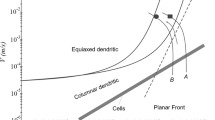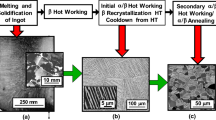Abstract
Experiments have been conducted to observe fragmentation events in a model alloy (succinonitrile and acetone) solidifying in the presence of forced convection in the superheated melt. Measurements of fragmentation rates have been made, and an attempt was made to relate the results to the controllable parameters of the system. A microscope-video system recorded the mushy zone-melt interface, and the fragmentation process and fragmentation rates could be determined from a frame-by-frame analysis of the video images. Experiments were conducted for varying cooling rates, overall temperature differences, melt flow rates, and for two different concentrations of acetone (1.3 and 6.1 wt pct). Significant dendritic fragmentation occurred for all runs. In addition, the influence of buoyancy forces is clearly evident from particle motion near the mushy zone-melt interface. Fragmentation rates appear to correlate well with the magnitude of particle velocities near the interface, with increasing fragmentation being associated with higher particle velocity magnitude (either in the same or the opposite direction to the mean flow) for the 1.3 wt pct acetone mixture. However, the correlation is quite different for the higher concentration. The relationship between these results and the possible mechanisms for fragmentation are discussed. Although it appears that either constitutional remelting or capillary pinching are likely of importance, hydrodynamic shear forces or some other mechanism as yet undiscovered cannot be completely discounted, although circumstantial evidence suggests that mechanical shearing is inconsistent with observations made both here and already in published literature. The results provide a step in the development of solidification models that incorporate fragmentation processes in the mushy zone as an important mechanism of grain refinement and a potential source of macrosegregation in ingots and large castings.
Similar content being viewed by others
References
Q.T. Fang: ALCOA Technical Center, ALCOA Center, PA, private communication, 1989.
C. Vives: Int. J. Heat Mass Transfer, 1990, Vol. 33, pp. 2585–98.
P. Desnain, F. Durand, Y. Fautrelle, P. Bloch, J.L. Meyer, and J.P. Riquet. Light Metals 1988, TMS, Warrendale, PA, 1988, pp. 487–93.
K.A. Jackson, J.D. Hunt, D.R. Uhlmann, and T.P. Seward: Trans. TMS-AIME, 1966, vol. 236, pp. 149–58.
M.S. Christenson and F.P. Incropera: Int. J. Heat Mass Transfer, 1989, vol. 30, pp. 47–68.
M.S. Christenson, W.B. Bennon, and F.P. Incropera, Int. J. Heat Mass Transfer, 1989, vol. 30, pp. 69–79.
E.R. Rubinstein: Ph.D. Thesis, Rensselaer Polytechnic Institute, Troy, NY, 1989.
S.C. Huang and M.E. Glicksman: Acta Metall., 1981, vol. 29, pp. 717–34.
P.W. Voorhees: Metall. Trans. A, 1990, vol. 21A, pp. 27–37.
D.M. Smith, J.A. Eady, L.M. Hogan, and D.W. Irwin: Metall. Trans. A, 1991, vol. 22A, pp. 575–84.
R.C. Kerr, A.W. Woods, M.G. Worster, and H.E. Huppert: Nature, 1989, vol. 340, pp. 357–62.
Q.T. Fang and M.J. Bruno: in Light Metals 1991, E.L. Rooy, ed., TMS, Warrendale, PA, 1991, p. 856.
N.B. Bryson, J.G. McCubbin, C.M. Read, P.G. Enright, and S.C. Food: International Patent Application Published under the Patent Cooperation Treaty, PCT/CA91/00216, International Publication Number WO 91/19578, 1991.
F. Durand: in Interactive Dynamics of Convection and Solidification, S.H. Davis, H.E. Huppert, and U. Mueller eds., NATO ASI Series E, Kluwer, Hungham, MA, 1992, vol. 219, pp. 55–59.
C.J. Paradies, G.T. Kim, M.E. Glicksman, and R.N. Smith: in Modeling of Casting, Welding and Advanced Solidification Processes—VI, T.S. Piwonka, V. Voller, and L. Katgerman eds., TMS, Warrendale, PA, 1993, pp. 309–16.
C.J. Paradies: Ph.D. Thesis, Rensselaer Polytechnic Institute, Troy, NY, 1993.
R. Zakhem, P.D. Weidman, and H.D. deGroh III, Proc. 1st Int. Conf. on Transport Phenomena in Processings, S.I. Guceri, ed., Technomic Publishing Co., Lancaster, PA, 1993, pp. 219–28.
Author information
Authors and Affiliations
Additional information
C. J. PARADIES, formerly Graduate Research Assistant, Rensselaer Polytechnic Institute
Rights and permissions
About this article
Cite this article
Paradies, C.J., Smith, R.N. & Glicksman, M.E. The influence of convection during solidification on fragmentation of the mushy zone of a model alloy. Metall Mater Trans A 28, 875–883 (1997). https://doi.org/10.1007/s11661-997-1016-3
Received:
Issue Date:
DOI: https://doi.org/10.1007/s11661-997-1016-3




